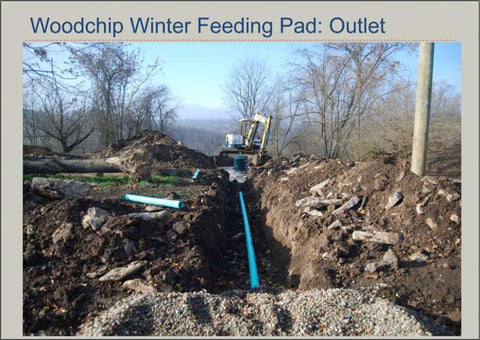Innovative Heavy Use Area for Bison

Submitted by:
Brian Farmer, Yankee Farmer’s Market
Date: August 8, 2014
Project Executive Summary:
The Innovative Heavy Use Area for Bison proposed by Yankee Farmers Market in Warner, NH, is a project that will demonstrate a method for nutrient management for a bison farm. Using the technical expertise of project partners Stanley Weeks, Ph.D. and Joshua Faulkner of the University of Vermont and local partners from UNH Cooperative Extension, Merrimack County Conservation District, and Natural Resources Conservation Service, this project aims to demonstrate effective heavy-use areas for bison that can be replicated in this growing industry throughout New Hampshire and the Northeast.
b) Primary area for consideration:
Yankee Farmer’s Market
360 Route 103 East
Warner, NH 03278
603-456-2833
The collaborators for this project include the following:
John Porter, UNH Cooperative Extension: Providing guidance for design and budget for HUA.
Dorothy Perkins, UNH Cooperative Extension: Providing guidance for design and budget for HUA.
Dr. Stanley A. Weeks, PhD. of Stanley A Weeks, LLC.: Providing agricultural engineering recommendations.
Joshua Faulkner, University of Vermont: Consultant for design and implementation of HUA and use of Woodchips.
Stacy L. Luke, Merrimack County Conservation District: Assisting in Project Management of the Innovative Heavy Use Area for Bison.
PROJECT DESCRIPTION
a) Project background:
Brian Farmer owns and operates a buffalo (bison) farm producing and distributing bison and bison products. Currently, the farm is in need of a Heavy Use Area (HUA) that meets the needs of the operation, and the animals, and addresses nutrient management concerns.
b) Project objectives:
This project relates to the NH NRCS State Priorities for Nitrogen Management related to active methods to improve the capture of nitrogen in manure management systems and provide the opportunity to recycle the manure nitrogen in lieu of synthetic fertilizers. This system will specifically address nutrient management issues for bison, which is a growing industry in New Hampshire for agricultural producers.
Creation of a more efficient feeding/holding area (HUA) with the use of concrete and wood chips that will:
- Improve water quality
- More effectively collect, store, and minimize nutrient runoff
- Reduce stress for animals & improve Animal health and gains
- Minimize feed waste
- Increase operational efficiency
- Allow for more vegetative buffers
- Increase pasture health
This project is innovative for New Hampshire as it will provide a solid example of a successful HUA that can be used by bison.
c) Project methods:
The largest component of the project is to design and implement an enclosed Heavy Use Area for buffalo (bison) utilizing concrete, hard pack, woodchips, and pipe/drain as seen in the designs below. This Innovative Heavy Use Area was presented by Joshua Faulkner of the University of Vermont and was recommended by Daimon Meeh of UNH Cooperative Extension. This specific design has been implemented, studied, and proven to be beneficial for the management of nutrients.





Provided by Joshua Faulkner, University of Vermont
d) Project area/location:
Yankee Farmers Market
360 Route 103 East, Warner, New Hampshire
Merrimack County


e) Producer Participation:
Brian Farmer of Yankee Farmer’s Market is the producer and participant with the goal of providing guidance and recommendations to other producers.
f) Project action plan and timeline:

g) Project management
Project Manager:
The project manager will be Brian Farmer, Yankee Farmer’s Market, 360 Route 103 East, Warner, NH 03278, 603-456-2833, yfm@tds.net. Brian has degree in engineering and has farmed buffalo for over 20 years. His experience is extensive with project management of many excavation, construction and agricultural practices. He has managed and implemented many NRCS EQIP practices as well as provided consultation for other producers.
1. Design of well-functioning HUA based on recommendations from below consultants
2. Budget analysis
3. Create a timeline for completion of sub-projects
4. Creation of proposal
5. Implement action items (listed above)
6. Maintain budget, record keeping, financial and other pertinent documentation
7. Evaluate efficacy of HUA
8. Host a workshop
Other key participations (subcontractors) providing guidance and expertise:
Daimon Meeh, UNH Cooperative Extension: Providing guidance for design and budget for HUA
John Porter, UNH Cooperative Extension: Providing guidance for design and budget for HUA
Dorothy Perkins, UNH Cooperative Extension: Providing guidance for design and budget for HUA
Dr. Stanley A. Weeks, PhD. of Stanley A Weeks, LLC.: Providing agricultural engineering recommendations.
Joshua Faulkner, MS and PhD in Biological and Environmental Engineering, University of Vermont: Consultant for design and implementation of HUA and use of Wood Chips.
Stacy L. Luke, Merrimack County Conservation District: Assisting in Project Management of the Innovative Heavy Use Area for Bison
Heather Foley, USDA Natural Resources Conservation Service, Merrimack County
Keira Farmer, Yankee Farmer’s Market: Design and budget analysis & administrative manager.
h) Benefits or results expected and transferability:

1. Provide an Innovative Heavy Use Area.
2. A workshop displaying the innovative practice in conjunction with project partners.
3. Share innovative HUA information with other Bison Producers in region.
4. Monitoring of the HUA with before and after pictures showing improvements.
Transferability Goal:
The goal is to create and maintain an effective HUA that will serve as a model for other livestock producers and provide information to EQIP.
i) Project evaluation:
Project will be continually monitored and maintained through record keeping, financial documentation, assessment of desired goals /results (see above) and through photo documentation pre and post construction. Progress and financial reports will be provided as needed.
j) Environmental Information and Assessment of Environmental Impacts:
The HUA is designed to minimize nutrient run off thus improving surrounding environment with particular attention to the Contoocook River Watershed. Bison farming is a sustainable and growing industry. Having a HUA that is designed for bison and can capture nutrients has a strong environmental impact on New Hampshire’s water bodies while providing an important social benefit to NH’s growing agricultural community.






